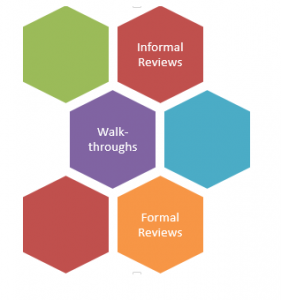
 Data Structure
Data Structure Networking
Networking RDBMS
RDBMS Operating System
Operating System Java
Java MS Excel
MS Excel iOS
iOS HTML
HTML CSS
CSS Android
Android Python
Python C Programming
C Programming C++
C++ C#
C# MongoDB
MongoDB MySQL
MySQL Javascript
Javascript PHP
PHP
- Selected Reading
- UPSC IAS Exams Notes
- Developer's Best Practices
- Questions and Answers
- Effective Resume Writing
- HR Interview Questions
- Computer Glossary
- Who is Who
Review the Right Way!
Reviews are a prominent part of the Software Development Life Cycle (SDLC). A review is a process of looking over a document/ piece of code for the purpose of evaluation, for examining the quality or for approval.

Types of Reviews
The reviews are done in various ways. But there are majorly three types of reviews. Informal reviews, Formal reviews and Walkthroughs.
Informal Reviews
Informal reviews are also known as Peer reviews. In this type of reviews, the reviewer gets his/ her documents or code verified by a peer (a co-worker). The findings of this type of review is not documented. This is majorly done to assess the content and the quality of the work.
Walk-throughs
The walkthroughs are generally done in the groups. The author of the document/ code leads the group by explaining the work to the group, from training perspective. The participants can suggest the gaps and improvement areas and can ask the questions related to the work.
Formal Reviews
In a formal review process, we usually have a planned time slot. The meeting room is booked and the attendees are informed. There has to be a reviewer, author, moderator and a recorder. The findings of the review is noted down by the recorder. The moderator will keep track of the time and moderates the review meeting.
Fundamentally what is the Difference?
- Let me give you a simple example to explain the difference. Imagine you are in School and your teacher has given an assignment that you need to complete at home. You did completed your homework properly. Now, you come to the school next day. Before your teacher comes to the class, out of curiosity, you ask your friend to check your assignment ensuring it is good and is complete. Your friend suggested some minor changes. You validated them and fixed few out of all the suggestions.This is called Informal Reviews.
- Now, the teacher arrived in the class and start checking the notebooks, one-by-one, where you have written the assignments. The teacher checks your assignment, mark it with the red pen wherever there were mistakes (highlighting the mistakes / gaps), and finally gave you a score. This is called Formal Review.
- The teacher liked your assignment, hence asked you to explain your assignment in the class, line-by-line. The class discusses the style and process of creation of the assignment and suggesting the improvement areas. The teacher is making notes of the suggestions. This is called Walk-Throughs.
The Review Process
A review process may have multiple steps and it may vary from Organization to Organization. However, the basic process will remain same. You can find some tweaks here and there depending up on the process and customer requirements.

In an informal review process, the reviewer reviews the work as per their level of understanding and suggests the changes. The reviewer validates the list of changes and may choose to fix few or all the suggested changes.
In Walkthrough, the author acts as a trainer and the participants becomes in reviewee. The purpose is not fault finding but to transit the knowledge and improvement of the quality of the work. One of the member makes notes about the suggestions. It depends on the author whether he/she wants to incorporate the suggested changes.
Following the Steps
A formal review process consists of defined steps. There are majorly five main steps involved in the formal review process:
- Planning
- Preparation
- Review
- Rework
- Follow-up
Planning
In the planning phase, a self-review of the work need to be done. The availability of the reviewer and other participants is requested. A meeting request should be sent accordingly along with the copy of the work, which needs to be reviewed.
Preparation
The next step is to get the confirmation from all the participants and get ready for the meeting. Moderator will moderate the meeting and keeps the track of the time. Moderator also ensures that everyone is on time and does not deviate from the topic while the review process is goes on.
Review
The review starts with the explanation of the work by the author. The recorder will keep the record of suggestions and corrections, which need to be made in the work. Reviewer(s) will review the work and suggests the changes and corrections. At the end of the meeting, the author will thank everyone.
Rework
After the meeting, the author will collect all the suggestions from the recorder and incorporate the suggestions in his/ her work. The updated document is emailed to the reviewer for final check.
Follow-up
In case, some more updates are required, the reviewer will communicate the same to the author directly. A follow-up is done on the fixing of the suggestions by the reviewed and a follow up is expected by the author for getting his/ her work reviewed and approved.
Reviews are crucial part of SDLC and are an important aspect of static testing. The reviews of every artifacts of a project has to be done to ensure the better quality output. It is not necessary to always opt for Walkthroughs or Formal Reviews as they are quite time consuming. We can also choose informal or peer reviews to get a check done on our work.


